When we were first seriously looking into adding goats to the farm, we did a lot of homework, a lot of reading, and we talked to various people more experienced than ourselves. Time and time again the same opinions kept cropping up. If looking for goats for milking some said “don’t get a first freshener your first time out“. The reasons given ranged from “she won’t let you milk her“, or “she’ll just dry up” to “first fresheners never produce much milk anyway“. While it’s true that milk yields in ruminants during a first lactation are typically lower than subsequent lactations, that doesn’t mean a first freshener can’t produce. The other tidbit of advice we were offered was “don’t waste your time trying to milk a dwarf goat, get a real goat if you want milk“. To which I now say some opinions are worth exactly what you pay for them. Right, Minnie?
As you may have already figured out, I have a tendency not to listen to some things I’m told, and prefer to find things out for myself. Sometimes it pays off, sometimes it doesn’t. After all, there was the apricot tree.
Start With a Doe in Milk, or Kids?
That was first question we had as prospective goat owners. After some thought, and consideration, I decided that there are pros and cons to buying a doe in milk the first time out, just as there are with starting out with kids. For one, finding quality does for sale, that are in milk, is much more difficult than finding quality kids. Breeders don’t tend to want to sell their proven best milkers, and who could blame them?
On the one hand, with a doe in milk, you hit the ground running with milking chores, in addition to learning the ropes in regards to care and feeding of a lactating ruminant, which in and of itself requires some considerable thought, and care.
If you’ve never milked a goat before, having to milk your first goat within hours of her arriving at your barn, could be quite daunting. Milking isn’t rocket science, but there’s a little more to it than just walking up and squeezing a teat! However, if you buy a doe that’s been milked before, at least the doe should be used to being milked.
On the other hand if you get kids, like we did, it will be a while before you have goat’s milk. You may find yourself bottle feeding for weeks on end.
Then a few months later you’re looking for a date for your young doe. Then of course, after breeding, there’s kidding. Great when it goes smoothly, but of course, as with anything in life, there are never guarantees, so you have to be prepared for all eventualities…again, more forethought, and planning.
Finally, a year or so later, as feed prices continually creep up, you might finally get your first goat’s milk, by which time you may wonder if raising goats makes any economical sense at all.
If you’re an instant gratification, or impatient sort, or are lucky enough to procure an excellent milking doe, it certainly might be worthwhile starting out with a doe in milk. However, we decided to muster up some patience, start out with kids, and work up to a daily milking routine. Start from the ground up so to speak. There’s no right or wrong approach, it’s mostly a matter of personal preference, and availability.
So, in March, after much anticipation, Lotus had her first kids. Triplets. We were now, finally, the proud owners of a first freshener.
We’d graduated bottle raising, breeding, pregnancy, and parturition. The time we’d been waiting for was finally here…milking!
Milking the Dreaded First Freshener
Although I’d milked goats before (more by machine than by hand), I’d never milked a Nigerian Dwarf.
About six weeks before Lotus kidded we noticed her udder was starting to form. Two weeks before kidding I wondered if perhaps those dwarf goat naysayers might be right. I have small hands, but…
Fortunately, I’d seen some lovely dwarf goats with beautiful udders, including her dam, so I knew there was a lot more to come. After all, at this stage she wasn’t even near kidding yet.
After she kidded, for a number of reasons, we pulled the kids from Lotus at the end of their colostrum period, and elected to bottle raise them this time around.
That meant it was time to start milking Lotus!
As I had some previous milking experience, my biggest concern when I first started hand milking Lotus wasn’t so much about technique, per se, as training, and behavior. As I hope to be milking Lotus for many more years to come, her first experiences on the milk stand could shape her attitude (and mine) for life.
Milking Started with Stanchion Training
The girls were already trained to the stanchion, and had been since they were tall enough to leap up there on their own.
Waiting until the first time I needed to milk to put a goat in a stanchion just seemed like asking for trouble. Any treats or grain have always been offered on the milk stand.
It’s no big deal to pick up a kid and put it on a stanchion, but I’m not lifting a full grown doe, in milk, any more than I have to, so I started out with the girls how I meant to go on.
So, getting Lotus on the stand, and securing the head-gate. No problem!
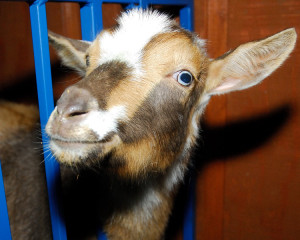
For Lotus using the stanchion has been part of normal daily life, making it one less hurdle to overcome at milking time
We also handle the goats a lot, from top, to bottom, so they’re not overly sensitive about being touched.
…and Then There’s the Milking Part…
I’ve recently had a number of emails from new goat owners, and been asked on Facebook, how I survived those first days milking my first – first freshener, and how on earth was I getting this much milk, twice a day, before the end of the first week.
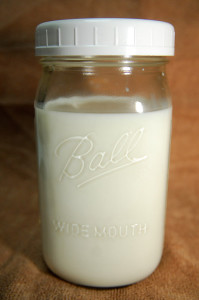
Just 5 days fresh, and we were over 3 cups of milk TWICE a day…it didn’t just magically happen though!
Well, some of it is that Lotus is actually a very sweet goat, and always has been. Some of it is I’m very stubborn, tenacious, and determined. The rest is patience, and perhaps the most important part, good milking genetics.
When Lotus first kidded, she had no trouble whatsoever with me helping to get her kids nursing soon after birth. However, a few days later, when it came around to milking her the first time, I got an emphatic “OH NO YOU DON’T” from Lotus, and the goat equivalent of ‘stink eye’ for even thinking I should be allowed to go anywhere NEAR her udder.
At first I wondered who was this goat?! What happened to my sweet snuggly Lotus, and how on earth did I suddenly become the enemy?! Oh, yes, that’s right…motherhood!
Milking wasn’t optional though, as I had three hungry, squeaky mouths to feed. Over the course of the first few days I got settled into my milking routine, and despite Lotus’ epic circa 1980’s breakdance performance on the milk stand, I actually did get some milk in the bucket. Some. Not much. But enough to start the kids on. The rest was on me, or in the straw. Baby steps. Deep breath. I’m a Brit…stiff upper lip. Keep calm, and carry on.
My milking skills were rusty, but I kept plugging away at it, same routine, same times of day, and after the third day, I was still convinced I was failing ‘Milkmaid 101’, and was sure this was NEVER going to work.
Persistence Does Pay Off
Through all of this my goal was to teach Lotus that kicking up a fuss was NOT going to make me stop milking. If she kicked, and I stopped, which is what she wants me to do, I’d be inadvertently rewarding her for kicking. This meant for the first few days I milked her one-handed. I held her hind leg nearest to me up, grasping just above the hock, and then milked with the other hand.

I simply placed a firm grasp on her hind leg closest to me, and raised the leg up. Not too much, so I didn’t throw her off balance
This is an old milk-barn trick, that often works, on the theory that goats can’t stand on just their two front legs. With one hind leg elevated, they can’t kick with the hind leg that’s down. I can say that’s not entirely true, and Lotus actually did stand on her two front legs quite well…albeit briefly, but holding up one hind leg did give me more control.
Some recommend hobbling goats. Personally, I absolutely abhor hobbles, for any animal. They’re frequently used incorrectly, and potentially very dangerous, and they teach the animal absolutely nothing. Besides, I don’t want to have to hobble a goat twice a day, every day, just to milk her. Although holding up one leg acts in a similar fashion to a hobble, the difference is I still have control, and I can use that to help teach her acceptable behavior on the milk stand long term. But that’s my preference. It was at this point, mid-milking, holding one hind leg up, that I was so happy we chose DWARF goats!
As I milked with one hand, and held her leg up with the other, I could feel if she started to relax. That allowed me to respond, and adjust my grip on the elevated leg. The more she relaxed, the more I relaxed, and soon she started to understand that she had some say in what was going on.

As Lotus relaxed, I’d loosen my grip, and gradually lower her leg back toward the milk stand. It’s important not to let go too soon to maintain some control
The key here of course, as with any training, is consistency. If she calmed down, she deserved to be rewarded for that. I expect the gradual improvement in my dwarf goat hand-milking technique, along with her starting to understand what to expect during milking, helped as well. Remember, this was new for her. Goat’s don’t innately know how to be milked by a clumsy human.
For the first few days she’d oscillate between kicking up an epic fuss, and having periods on the stanchion where she’d calm down for a moment. If she was calm, I’d slowly lower her hind leg, but if she tensed or kicked again, I’d raise it back up. If she wanted to stand normally, all she had to do was stop kicking. Once that concept registered, she improved quickly, and the calm moments began to exceed the chaotic ones. It was all about giving her control.
From the beginning, if Lotus started to kick, lay down, defecate on the milk stand (oh yes, she did), step in the bucket (uh huh), kick the bucket (now you know where that term comes from) all the way over and dump the milk in my lap, I didn’t stop milking.
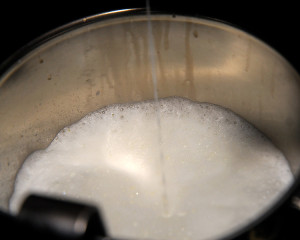
To avoid the risk of broken glass in the barn, I prefer to use a small 1 quart stainless steel bucket
To prevent losing all the milk on the floor, I always kept a milk tote with me, and as I got some milk in the bucket (providing Lotus was calm) I’d stop for a moment, pour it off into the tote, and resume milking.

Keeping a vessel close at hand, with a secure lid, allows you to pour off some your gains before they get kicked across the barn floor!
Once I had enough milk for the kids, if Lotus knocked the bucket over, I just kept milking, even if I milked her out onto the barn floor. I felt it was more important that we get the milking mechanics down, and focus on rewarding the right behavior.
Looking back now I can laugh, but at the time I remember thinking that milking a dwarf first freshener required a lot more agility, stamina, and tongue-biting than I’d expected, and maybe I should have listened to those naysayers. However, reviewing her milk records, we actually went from one handed milking, with Lotus on three legs (and occasionally two), to a calm, relaxed goat, chewing her cud, and two-handed milking, in just under a week.

If you’re new to milking, don’t rush moving on to two handed milking until you, and your goat, are very comfortable with the one hand method
Since then we’ve been working together as a team, and milking, I’m happy to say, is no longer a chore.
Of course, that said, I’ll be interested to see how well Minnie stands on two legs next year…if I know Minnie, she might even try to stand on one leg!
All that effort was worth it though, because then this happened…
To the first freshener and dwarf goat naysayers, this is proof that even with ONE dwarf goat in milk, you can still fill a fridge. This is less than one week’s worth of milk, from a single dwarf goat, that is still feeding three kids. In other words, this is the SURPLUS milk, that we haven’t already turned into goat’s milk ice cream, or cheese. At six weeks fresh, she’s now producing almost 5lbs of milk a day, which is very respectable for a goat her size.
I honestly couldn’t have asked for more from a first freshener dwarf goat. Lotus has exceeded even my expectations during this freshening so far.
I’m very happy with how quickly she settled down, and adjusted to her new role as a milking doe, and yes, for those that are interested, I am so completely regretting not doing DHIA this year.
We can track milk volume and weight, but I’m looking forward to knowing more about her milk composition, including protein, and butter fat. C’est la vie. Next year!
If You Want Milk…Choose Your Goats Wisely
That’s the take home message. We wanted to bring dairy goats to the farm primarily for milk, so we were careful to select goats with excellent milking genetics. Not all goats, even of the same breed, are created equal. Quality milking goats come from good quality milking lines. You can’t take a rag-tag, poorly bred, scrawny goat, tied to a stake in a back yard, throw brown hay at it, and it expect it to perform in the milk pail. Quality dairy goats are an investment, as is their care and feeding. The results are absolutely worth it…

Yes, that is a spoon full of goat’s milk cream! It’s not whipped, this is just what naturally floats to the top of the jars…
I had expected I’d have to wait until the kids were weaned before venturing much further into cheese making, but I don’t think waiting any longer is really an option. This weekend maybe I’ll finally try my hand at a bloomy rind cheese! I’ve always wanted to make a bloomy rind cheese.
Earlier this week I also ordered some supplies for making our first cold-process goat’s milk soap, too! After all, between fresh goat’s milk, honey, beeswax, and all the aromatics in the herb and flower gardens, making our own soap for the farm just makes sense. Not to mention that between cheese, and soap, maybe we can put off upgrading the refrigerator until next year!


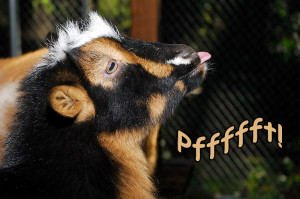




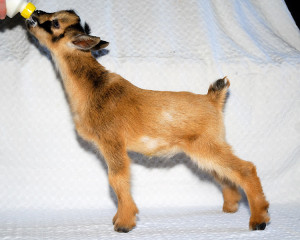

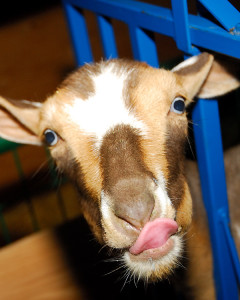
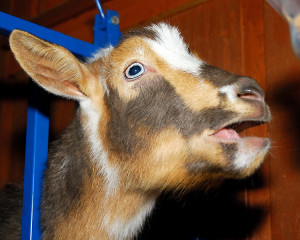
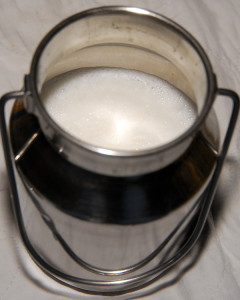
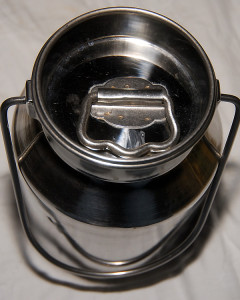

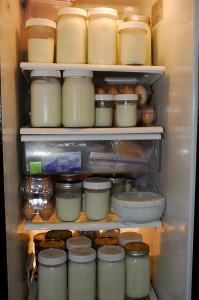
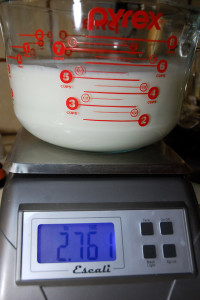
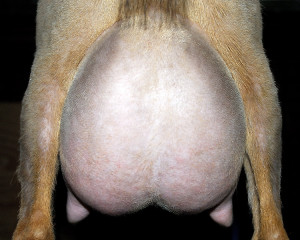
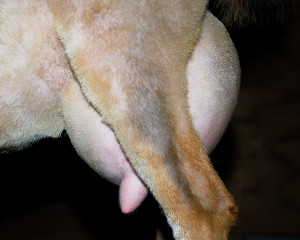
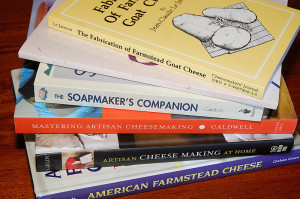







You are certainly a goat expert, and your goats are adorable! I will never be a milkmaid or a goat owner, but that’s OK. I will always enjoy reading about them/seeing them on your blog. This is both an entertaining and informational post–not an easy thing to accomplish!
I find the goats to be very entertaining, so it’s always easy to write about them. I still have a lot to learn about them though. They’re like bees in that sense. Just when you think you have them all figured out…they’ll throw you a curve 😉
Well done!
Many years ago while living with my grandparents, a neighbor made goat’s milk cottage cheese. It was so good. I can still recall the taste even though it was sixty-five years ago.
I’m sure you’ve got a lot to do, but how about some pictures of the kids?
I’m sorry Ed, I realized yesterday that although I had put some kid pictures on Facebook the other day, that I actually haven’t updated the blog with new kids pics since they were born! I promise, the next goat post will be all about them! 🙂
Persistence wins out,…You must have needed a nap after a milking session. But, oh, what fun to make all kinds of things with the milk,…and cream. Goat half & half for coffee?
Actually, that’s the advantage of dwarf goats…they’re not all that physically demanding compared to a full size dairy breed.
As for half-and-half, I drank non-fat milk for years (I know *gasp*), so fresh-from-the-goat milk almost seems like heavy cream in comparison! It is really good in coffee 😉
Wow, what great success! It is so fascinating to read about your journey with your goats. They are absolutely adorable! Melts my heart!
Ha! Not quite so adorable standing on two front legs with the hind legs kicking like a bucking bronco on the milk stand 😉 If nothing else, through this experience, I’ve learned that even the sweetest goat on earth has an inner drama-queen buried deep in there somewhere 😛 I’m so glad she’s back to her sweet, and mellow, self!
I’m amazed, but your persistence paid off, and I really enjoyed learning of your technique on training her. Sounds so simple and logical, yet I’m not sure I would have ever thought of it! That’s a lot of milk, too!
I was fortunate that Lotus is a pretty smart cookie, and was willing to work with me on this. I have seen some goats, that no matter what you do, they’ll still lay down, flip upside down, and persist in their tantrums on the milk stand. The vast majority though, with patience, are just fine. I think that’s something to be wary of if/when buying a goat that’s been milked before…you never know how that goat behaved during milking, or how she was handled…until YOU have to milk her. 😉
Wow, I am udderly impressed! Someday you should write a book on your Curbstone Valley experiences.
Ha ha! Very punny! I’m not sure about a book…at the moment I can barely keep up with the blog! 😛 It might be fun to have a permanent record of all the crazy on the farm though. Something to reflect on in my dodderage…
Wow — what a lovely yield. You make it sound reasonable. Perhaps. . . too reasonable! I keep telling myself I am NOT going to get goats, no matter if the regulations in town are changed. no, no, no. . . It’s just lovely, both the training regimen and the results.
Careful, I said “no, not happenin’, noooo way” for about 5 years. I thought I had my reasons then, but I couldn’t imagine NOT having goats now. Besides, we’re in the middle of making a raw goat’s milk feta today, and the yield was TWICE was the recipe said we should we get, and the color of the curds looks simply divine! I can’t wait to try it!
Besides, we’re in the middle of making a raw goat’s milk feta today, and the yield was TWICE was the recipe said we should we get, and the color of the curds looks simply divine! I can’t wait to try it!
Oh my, the little ones are so cute. Your experience of milking was quite humorous. I bet they can be a handful. That was interesting that one has to select the ‘right’ goats too. I had no idea that if you want milk, not all goats are good producers.
The right goats really do matter. It’s very important to choose goats that have been selected specifically for dairy production, if milk is the priority. You can have the most stunningly beautiful goat in the show ring, but if she doesn’t perform in the milk pail, do the looks really matter?
And yet another skill, another product and more learning for all of us…I hope what you make from the goat’s milk will be for sale so we can purchase it… especially from such a sweet goat.
In a perfect world, I’d love to sell cheese, but unless we move somewhere flatter, where we can build a CDFA certified dairy facility, that can’t happen. Maybe someday. In the meantime though, I am about to venture into soap making. Once I have some recipes I’m happy with, I might sell some, at least locally. First we’ll have to see how it turns out 😉
As I was reading I was thinking, actually smaller goats would be easier to handle. Seems that thought was right. Glad Lotus settled down so quick though, it can’t have been too fun having milk kicked all over you.
The milk was warm, and a little damp 😉 I mostly just wanted to her to not be so anxious about being milked. Now she gets impatient if I don’t hustle when I get down the barn and get set up for milking. She even grunts at me if I’m moving too slow!
Pooping on the stanchion? Not shy about her opinions, is she? Having nursed my daughter for 15 mos, I can empathize with Lotus wanting to be milked! Ahhh, sweet relief. 🙂
No, she’s not shy at all! That only happened once, during an epic meltdown, mid-tantrum. I was just grateful not to get a pair of hooves to the eyebrow! I do think that part of what settles them down though, is that they do feel more comfortable after milking. I just think it takes a few sessions for that to sink in 😉
This post must be incredibly handy for goat millers but I found it fascinating too. I would think another reason for getting kids would be to develop a relationship with the little goat as it grew rather than start with a fully formed personality.
Definitely! I think of purchasing goats a little like buying a car. If you buy one that’s been ‘previously owned’, you don’t know how that goat’s behavior was shaped. The advantage of kids is you can raise them the way you want them, and form that bond with them early on 🙂
That was a fascinating account of milking and boy, would I love to try the feta cheese you made. gail
The feta was very good. I think next time we won’t drain it for as long. Using raw goat’s milk, our cheese yield was phenomenal, but it also seemed a little more dense, perhaps a result of higher protein in the milk, so I don’t think the drain time needed to be as long. That’s the fun part though, now we get to experiment!